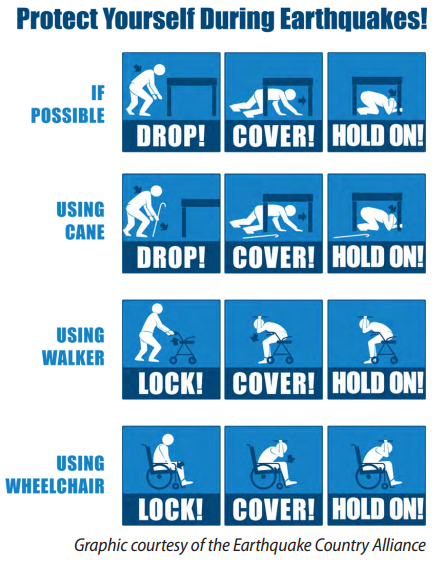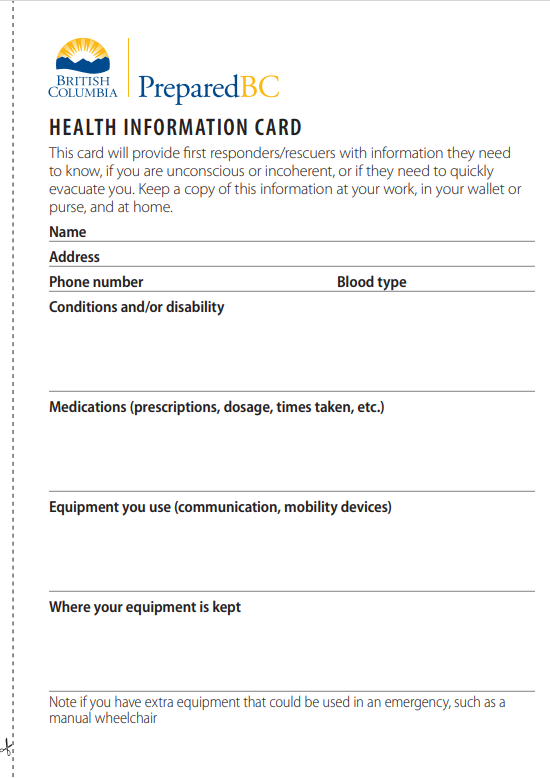People With Additional Needs
It’s important to be prepared by knowing the risks in their community, having a household plan and having an emergency kit. Having a disability means you might need to consider preparedness actions above and beyond the “basics”. PreparedBC has some excellent resources to guide you on what to think about, including:
- Your ability to communicate - it could be restricted
- Your surroundings - could change and look unfamiliar
- Your service animal or guide dog - could be hurt or frightened
- Your health could be impacted by stress or confusion
Disasters can be overwhelming, and stress could make some conditions worse. You might even have to ask for assistance in circumstances you usually do not. Be sure to talk to someone about how you are feeling and reach out for help if needed.
Important steps to take
Know the risks
Hazards vary depending on where you live and knowing which ones you face will influence how you prepare. Below is a list of the top 10 risks in B.C. Familiarize yourself with the ones that could occur in your area by contacting your band office, municipality, regional district or local authority.
- Earthquakes
- Tsunamis
- Floods
- Landslides
- Avalanches
- Severe weather
- Power outages
- Hazardous materials spills
- Wildfires
- Disease outbreaks
Learn more: Know the Hazards | RDN
Prepare your home
- Identify the risks for your region
- Make an emergency phone list with at least one out-of-area contact
- Pick a meeting spot if you’re separated from friends and family
- Assign someone to collect your children from school or daycare if you can’t
- Identify what sources you’ll get official information from
- Learn how to turn off utilities. ¨ Store enough emergency water for those you live with
- Store enough food to support those you live with for three days to two weeks
- Identify any special needs, such as medications, and make sure a proper supply is on hand
- Secure your space
- Create grab-and-go bags
Source: Prepared BC: Resources for People with Disabilities
Learn more: At Home | RDN
Make a plan
Don’t forget to review it on a regular basis. Knowing the risks, practicing your emergency plan, having an emergency kit with specific supplies and building a trusted support network means the best chance for recovery. Also download the companion PreparedBC Home Emergency Plan. Fill in the blanks, talk to those you live with and your neighbours about it and keep a copy with your emergency kit.

Source: Prepared BC: Resources for People with Disabilities
Learn more: Create a Plan | RDN
Gather emergency supplies
Have enough non-perishable food and water to support you and those you live with for at least three days to two weeks. If the power is out, use the food from your fridge and freezer first, followed by your pantry. Water is the most important item to store—you will need at least four litres (one gallon) of water per person, per day. Ensure you have a suitable food and water supply for babies, toddlers, pets and service animals and check expiry dates every six months. Replenish or renew as needed.
If you take restricted medications or those administered by a health professional, talk to your doctor about how you should prepare for a disruption caused by a disaster.
Source: Prepared BC: Resources for People with Disabilities
Learn more: Get Prepared | RDN
Personal support network
Consider building a trusted support network of at least three people to assist you during an emergency. Some things to discuss and implement prior to an emergency:
- Make arrangements for your support network to immediately check on you after a disaster and, if needed, offer assistance
- Exchange important keys and any relevant medical information
- Discuss any health conditions or medications and show them how to operate specialized medical or mobility equipment, such as lifts, wheelchairs or scooters
- Decide on and practice methods for contacting each other in an emergency - do not count on telephones working
- Show them where you keep emergency supplies
- Share copies of and discuss your emergency plan
- Agree to always notify each other when you are going out of town and when you will return
Plan multiple ways to get and give information, such as a corded landline/ TTY, mobile phone/ text messaging, two-way radio, portable radio and extra batteries, pager or pencil and paper.
Health information card
C-MIST framework for emergency planning
Disability Alliance BC recommends beginning your personal emergency planning process using the five categories of the functional needs, or C-MIST (Communication, Medical, Independence, Supervision and Transportation), framework.
| Communication | This category includes people who have limited or no ability to speak, see, hear or understand. During an emergency, people with communication needs may not be able to hear announcements, see signs, understand messages or verbalize their concerns. |
| Medical | People in this group require assistance in managing activities of daily living such as eating, dressing, grooming, transferring and going to the toilet. It includes managing chronic, terminal or contagious health conditions (such as ongoing treatment and administration of medications, IV therapy, catheters, tube feeding, dialysis, oxygen, operating lifesustaining equipment...) During an emergency, people may be separated from family and friends. Early identification of these needs and intervention can avoid deterioration of health |
| Independence | This includes people who are able to function independently if they have their assistive devices and/or equipment. Items consist of mobility aids (such as wheelchairs, walkers, canes, crutches); communication aids; medical equipment, (such as catheters, oxygen, syringes, medications); and C-MIST Barbara Purdy Emergency Planning 2 service animals. Individuals may become separated from their assistive equipment and/or animals in an emergency. Those at risk whose needs are recognized and restored early are able to maintain their independence and manage in mass shelters. Effectively meeting their functional needs prevents secondary complications. |
| Supervision | People with supervision needs may include those who have psychiatric conditions (such as dementia, Alzheimer, Schizophrenia, depression or severe mental illness); addiction problems; brain injury, or become anxious due to transfer trauma. During an emergency, some people with mental illness may be able to function well while others require a more protected and supervised setting. |
| Transportation | Emergency response requires mobility and this category includes people who are unable to drive because of disability, age, temporary injury, poverty, addiction, legal restriction or have no access to a vehicle. Wheelchair accessible transportation may be necessary. Pre-planning evacuation needs helps prevent chaos during an emergency and many people can function independently once evacuated to safety. |
Sources: Prepared BC: Resources for People with Disabilities, Emergency Preparedness for People with Disabilities | DABC
Service animal preparedness tips and checklist
The following are basic items you should have on hand to keep your pet or service animal comfortable during an emergency. Make sure the kit is accessible and easy to transport in case you are required to evacuate.
- Minimum 72-hour supply of bottled water and pet food, including pet dishes
- Manual can opener (if storing canned food)
- Leash and collar/harness
- Recent photo of your service animal in case they get separated from you
- Blanket and toy
- Plastic bags and paper towels
- First aid kit for treating minor wounds on paws
- Medical/vaccination records and list of medications identifying any medical condition, dosage, frequency and contact information of prescribing veterinarian
- Up-to-date ID tag with your phone number and the name/phone number of your veterinarian
- Copy of licence (if required)
Pets and service animals may become confused, frightened or injured during or after a disaster. You may have to keep them confined, securely leashed or harnessed.
Sources: Prepared BC: Resources for People with Disabilities
Useful links
- PreparedBC emergency guides and resources (PreparedBC)
- Disability Alliance of BC
- Creating Safe Communities: Local Governments’ Legal Duty to Accommodate People with Disabilities in Emergency Response
- A Shared Responsibility: The Need for an Inclusive Approach to Emergency Planning for People with Disabilities
- Learning CMIST: Trainer the Trainer – Helping Individuals with Disabilities Create Emergency Preparedness Plans
- Prepare to Survive – Prepare to Help: Community Training in Emergency Planning for People with Disabilities: Prepared by Hatching Change Collective members Tammie Tupechka, Maryann Abbs and Eric Doherty for DABC (then called BC Coalition of People with Disabilities) and Volunteer Canada – November 2010. English version French version

